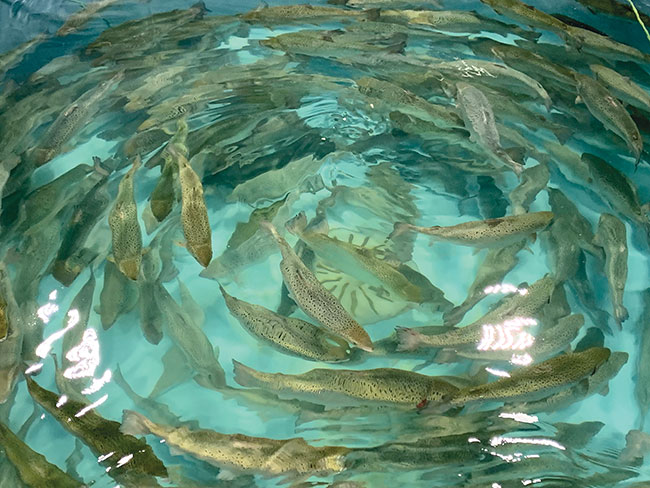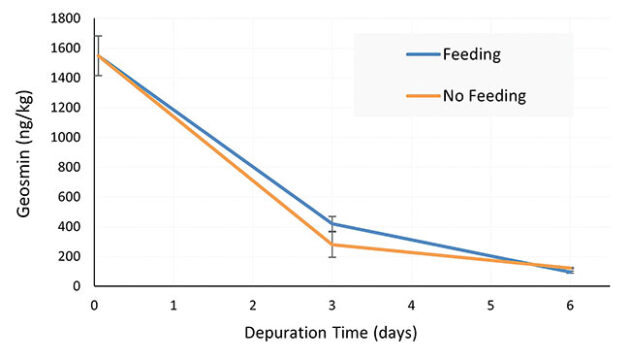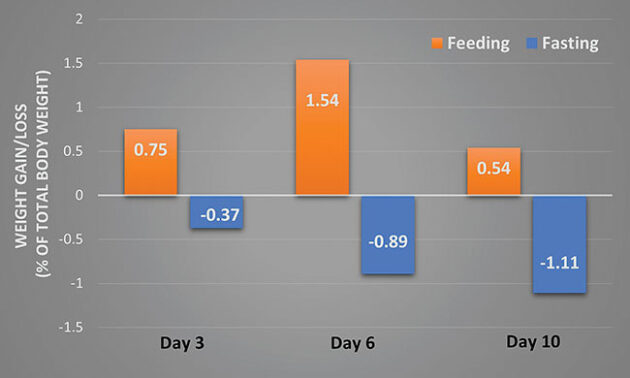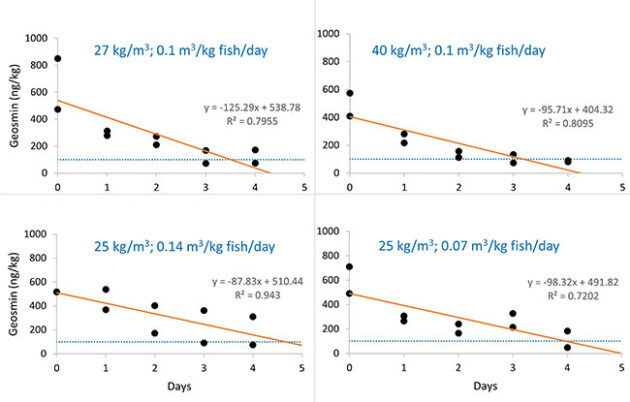
Features
Fish Nutrition
Hatchery Operations
Research
Evaluating the feasibility of feeding RAS-produced fish during the depuration process
March 14, 2024 By John Davidson, Snir Azaria, and Jaap van Rijn The Conservation Fund’s Freshwater Institute The Hebrew University of Jerusalem
 Depurating fish often leads to notable body weight loss.
Photos: Freshwater Institute
Depurating fish often leads to notable body weight loss.
Photos: Freshwater Institute Depuration, also known as purging, is a pre-harvest procedure that removes earthy, musty off-flavour from RAS-produced species.
To begin, market-size fish are transferred from RAS into flowthrough or partial reuse systems where water containing negligible off-flavour is exchanged while withholding feed. Under these conditions, unpalatable compounds like geosmin (GSM) and 2-methylisoborneol (MIB) are eliminated by fish across a concentration gradient with the surrounding water. Feed is typically withheld i) to reduce fish stress prior to slaughter, ii) to eliminate digestive tract waste for sanitary processing, and iii) to create a low-nutrient environment that limits undesirable off-flavour-producing bacteria.
Depurating fish are usually kept off feed for five to 14 days depending on species and site-specific parameters including somatic lipid levels, water temperature, and the system flushing rate applied per fish biomass. Although depuration is generally a fail-safe method for remediating off-flavour, this procedure does have several drawbacks including significant water use, additional fish handling, and notable fish weight loss, the last of which is the focus of this article.

Figure 1. Geosmin and MIB levels in fed and fasted Atlantic salmon during a six-day depuration period (Davidson et al., 2023).
Fish weight loss
Several studies with Atlantic salmon have shown that the fasting period that coincides with depuration results in fish weight loss. Burr et al. (2012) found that salmon weighing 2.4 kg lost 3.8 of their body weight after five days of depuration and 5.8% after 20 days.1
Similarly, May (2020) reported that 7-8 kg Atlantic salmon, lost 2.1% of their body weight after six days of depuration and 4.2% after 14 days.2
From a commercial perspective, fish weight loss occurring just before harvest could result in reduced revenue. Concern about the welfare of fasting fish has also been expressed. However, the results of several studies suggest that the short fasting periods used to depurate salmonids do not cause harm to the fish.3,4,5 Nevertheless, shortening the fasting period during depuration could reduce welfare concerns and negative perceptions of this procedure.
Based on this background, researchers at the Freshwater Institute (FI) and the Hebrew University of Jerusalem (HUJ) designed and carried out several depuration studies that characterized weight loss in three commercial species commonly produced in RAS: Atlantic salmon, rainbow trout, and barramundi. Studies with Atlantic salmon and rainbow trout also examined the impact of feeding on fish weight loss and off-flavour elimination during depuration. This research was funded by the Binational (U.S./Israel) Agricultural Research and Development Fund (BARD).

Figure 2. Weight loss percentages in fed and fasted rainbow trout over a 10-day depuration period.
Feeding depurating salmon
During this initial study, 3-4 kg Atlantic salmon produced in FI’s water reuse systems were moved to separate tanks where a representative number of fish were tagged with passive integrated transponders (PIT).
Two weeks later, the fish were exposed to concentrated GSM and MIB to boost flesh concentrations. After two days of feed withdrawal to clear the gut, the salmon were weighed and divided into eight partial reuse systems with 5 m3 tanks at a stocking density of 55 kg/m3. The system volume was replaced seven times per day through continuous spring water addition, and temperature was maintained at 14.9 C. Feed was either offered during four of six days of the depuration period or withheld entirely (n=4). On Days 0, 3, and 6, fillet samples were collected and later analyzed for GSM and MIB using solid phase microextraction mass spectrometry (SPME-MS) procedures.
Salmon from both treatments rapidly eliminated GSM and MIB (Fig. 1), but significantly lower levels remained in fish that were fed, albeit the differences were relatively small. After six days, fed and fasted salmon lost 0.3 and 1.1% of their initial body weight, respectively (P<0.05). Therefore, feeding minimized salmon weight loss without compromising off-flavour removal.
We also noted that different preliminary gut evacuation methods have been applied across similar depuration studies. For example, Burr et al. (2012) began with fish that had not been fasted before depuration.1 As such, some of their reported weight loss was likely associated with excreted waste, which is irrelevant to sellable product weight. Extending the preliminary off-feed period to two days, as was done during our study, eliminated digesta from the fish gut, thereby negating false weight loss measurements.
Moreover, salmon processing data suggested that most of the weight loss occurred in the visceral mass; thus, cost implications likely depend on the final product form (whole fish, head-on-gutted, or fillets) and whether value is generated from the offal. Associated economic modelling for whole-body fish sales showed that minimized weight loss could result in US$250,000 of additional revenue for a 5,000 mt/year salmon RAS facility.
This research was described in a recently published article in the Journal of Applied Aquaculture.6

Figure 3. Geosmin levels in depurating barramundi at different stocking densities and flushing rates. Broken lines indicate approximate human threshold of detection at 100 ng/kg.
Feeding depurating trout
During a second FI study, 4.2 kg rainbow trout (steelhead) originally raised in a semi-commercial scale RAS were moved to two 18 m3 depuration tanks where the water volume was exchanged 6-7 times daily, and temperature was maintained at approximately 13.5 C. Some of these trout were PIT-tagged for identification, but the fish were not exposed to concentrated off-flavour.
The focus of this study was to compare weight loss while feeding or fasting rainbow trout in a depuration setting. Fed rainbow trout were offered a high-energy diet for seven of ten depuration days. Feed was withheld on Day 0 and Day 1 to minimize stress and Days 8-10 to evacuate the gut.
In summary, fed rainbow trout increased their body weight by 0.54%, while fasted trout lost 1.11% of their body mass after 10 days of depuration (Fig. 2). Average GSM and MIB levels were <100 ng/kg in fish from both treatments, and feeding did not negatively affect off-flavour concentrations.
Depurating barramundi
In a study conducted at HUJ, barramundi (approximately 600 grams mean weight) were stocked in a common tank and exposed to concentrated GSM. Six hours later, the fish were weighed and moved to replicated 0.4 m3 tanks at densities of 25 kg/m3 or 40 kg/m3 where they were purged for five days without feeding.
Depuration was examined as a function of flushing rate (0.07, 0.10, and 0.14 m3 water/kg fish/day) and fish density. Each stocking density and water exchange combination was tested in duplicate depuration systems. Two fish from each treatment were humanely euthanized each day and fillet samples were collected and analyzed using SPME-MS.
Geosmin levels in barramundi flesh steadily decreased for all treatments. Between Days 3 and 4, average GSM levels were approximately 100 ng/kg (Fig. 3), which is around the threshold of human detection in barramundi as determined through research by Azaria et al. (unpublished). Therefore, it can be concluded that off-flavour was effectively remediated under all tested depuration conditions.
However, unlike the previously described studies with salmonids, barramundi did not lose weight during the four-day depuration period, therefore research evaluating the effects of feeding was not required for this species.
Practical perspectives
Feeding depurating Atlantic salmon and rainbow trout appears to be a viable approach that reduces fish weight loss without negatively impacting the rate of off-flavour elimination, which could result in economic benefits. However, these findings should be considered with specificity to the applied procedures.
For example, the depuration systems used at FI were brushed to remove microbial biofilms and disinfected with 200 mg/L hydrogen peroxide before stocking fish, which is standard practice at this facility. Moreover, the dual-drain culture tanks created hydraulics that rapidly removed feed and fish waste through a bottom center drain. These aspects may be critical to maintaining effective off-flavour removal while feeding depurating salmonids.
Feeding fish during depuration also increased solids and nutrient levels in the effluent, which could affect waste discharge levels or the feasibility of reusing depuration system effluent as supply water for RAS.
Decisions to feed depurating fish may depend on these factors and other site-specific variables such as the selected fish species. For example, as demonstrated with barramundi, feeding was not required to mitigate weight loss for this species during a four-day depuration period.
Disclaimer: This research was approved by the Institutional Animal Care and Use Committees at each facility.
References
1 Burr, G., Wolters, W., Schrader, K., & Summerfelt, S., 2012. Impact of depuration of earthy-musty off-flavors on fillet quality of Atlantic salmon, Salmo salar, cultured in a recirculating aquaculture system. Aquacultural Engineering 50, 28–36.
2 May, T., 2020. Quantifying off-flavor effect on profitability. RASTECH Magazine, September 1, 2020.
3 López-Luna, J., Vásquez, L., Torrent, F., & Villarroel, M., 2013. Short-term fasting and welfare prior to slaughter in rainbow trout, Oncorhynchus mykiss. Aquaculture 400–401, 142–147.
4 Hvas, M., Stein, L.H., Oppedal, F., 2020. The metabolic rate response to feed withdrawal in Atlantic salmon post-smolts. Aquaculture 529, 735690.
5 Hvas, M. et al. (7 coauthors), 2022. Full compensatory growth before harvest and no impact on fish welfare in Atlantic salmon after an 8-week fasting period. Aquaculture 546, 737415.
6 Davidson, J., Schrader, K., May, T., Knight, A., & Harries, M., 2023. Evaluating the feasibility of feeding RAS-produced Atlantic salmon (Salmo salar) during the depuration process: effects on fish weight loss and off-flavor remediation. Journal of Applied Aquaculture. Published online 9/27/2023.
Print this page
Advertisement
- Pacific salmon breeding plan is outperformed in Russia
- National Fisheries Institute welcomes new media & communications manager





